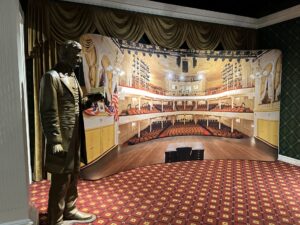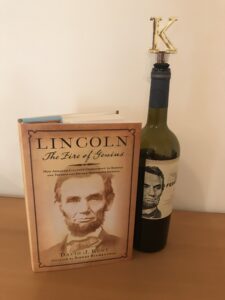 Ford’s Theatre plays an important role in the legacy of Abraham Lincoln. It was here that Lincoln was assassinated by a slavery sympathizer and actor. Today, Ford’s does double duty as a working theater and a memorial to our 16th president. Last night I did something I had never done in all my years of going to Ford’s. I took an after-hours tour.
Ford’s Theatre plays an important role in the legacy of Abraham Lincoln. It was here that Lincoln was assassinated by a slavery sympathizer and actor. Today, Ford’s does double duty as a working theater and a memorial to our 16th president. Last night I did something I had never done in all my years of going to Ford’s. I took an after-hours tour.
Called “Ford’s @ 5,” the theater has been offering a limited series of tours this summer. They begin at 5:00 p.m. on Sunday, after the theater and museum close to the general public. And they are wonderful.
About a dozen of us gathered in the main lobby. Promptly at 5 p.m., we were escorted by Sophie, our tour guide for the evening, down the ramp and stairs into the basement museum. Using the displays as props, Sophie gave us the history of Washington in Lincoln’s time, as well as insights into Lincoln’s family, the war, and, of course, the assassination. We learned about how the unfinished dome of the Capitol became an important symbol. Lincoln wanted construction to continue even during the war to show that the work of democracy continues. We heard about the death of Willy Lincoln in 1862 and how Mary Lincoln rejuvenated the dilapidated White House (perhaps with more exuberance than funding allowed). We heard about how John Wilkes Booth stalked Lincoln around Washington, turning his kidnapping plan into a murder plan as the South was surrendering and Lincoln was voicing a desire that African Americans be allowed to vote.
And then it was time to enter the theater itself. Sophie explained the reason Lincoln attended the theatre that night, how Booth used his fame and influence to gain access to the presidential box, and how he expressed delusion and disdain for democracy as he jumped to the stage for his escape. Sophie’s narrative added important insights into the scene around us as we gazed down at the stage and across at the flag-draped box from our balcony seats. As a special treat, Elinor, another guide who was tagging along with the tour, opened up the door to the presidential box so we could each in turn get a close-up view of where Lincoln, Mary, Henry Rathbone, and Clara Harris were seated during the attack.
To top off the tour, wine and cheese was served in the lobby, giving us time to ask additional questions and chat further with Sophie and Elinor. Check the Ford’s website to see if any spots are available for future Ford’s@5 events.
The Ford’s tour wasn’t the only Lincoln I experienced that day. Prior to the tour I visited the Smithsonian National Portrait Gallery, a block or two up the road from Ford’s. As Wendy Swanson detailed in a post on the Lincolnian website in May, the Portrait Gallery is currently featuring a special exhibit called “Picturing the Presidents: Daguerreotypes and Ambrotypes.” Early photographs of several presidents, including the four immediately preceding Lincoln, are featured with two ambrotypes of Lincoln himself. While at the Gallery, I couldn’t pass up the chance to visit with the life-size W.F.K. Travers painting of Lincoln installed a year or so ago.
Lincoln doesn’t stop there, however. Several members of the Lincoln Group of DC have already signed up for “Mister Lincoln,” a one-man show about the 16th president featuring renowned actor Scott Bakula (Quantum Leap, NCIS: New Orleans, Star Trek: Enterprise). The show runs at Ford’s Theatre from September 20 through October 13, 2024.
[Photo from inside Ford’s Theatre Museum by David J. Kent, July 28, 2024; This post with additional photos was originally published at Lincolnian.org]

Lincoln: The Fire of Genius: How Abraham Lincoln’s Commitment to Science and Technology Helped Modernize America is available at booksellers nationwide.
Limited signed copies are available via this website. The book also listed on Goodreads, the database where I keep track of my reading. Click on the “Want to Read” button to put it on your reading list. Please leave a review on Goodreads and Amazon if you like the book.
You also follow my author page on Facebook.
David J. Kent is Immediate Past President of the Lincoln Group of DC and the author of Lincoln: The Fire of Genius: How Abraham Lincoln’s Commitment to Science and Technology Helped Modernize America and Lincoln: The Man Who Saved America.
His previous books include Tesla: The Wizard of Electricity andEdison: The Inventor of the Modern World and two specialty e-books: Nikola Tesla: Renewable Energy Ahead of Its Time and Abraham Lincoln and Nikola Tesla: Connected by Fate.



 A funny thing happened on the last
A funny thing happened on the last  I recently returned from a 16-day trip to southern Africa. I’m still recovering from the 15-hour flight from Cape Town back to America (and the three-and-a-half-hour flight from Zimbabwe before that) but wanted to get an overview of the trip up as a preamble to more detailed future posts. The trip took us to South Africa, Botswana, Zimbabwe, and unexpectedly, Zambia.
I recently returned from a 16-day trip to southern Africa. I’m still recovering from the 15-hour flight from Cape Town back to America (and the three-and-a-half-hour flight from Zimbabwe before that) but wanted to get an overview of the trip up as a preamble to more detailed future posts. The trip took us to South Africa, Botswana, Zimbabwe, and unexpectedly, Zambia. The fourth of July, our annual anniversary of the signing of the Declaration of Independence, has always a day of commemoration. Throughout his life, Abraham Lincoln attended many of these celebrations. But July 4, 1848, was even more special than usual. On that date, Lincoln watched the cornerstone of the new Washington Monument being laid.
The fourth of July, our annual anniversary of the signing of the Declaration of Independence, has always a day of commemoration. Throughout his life, Abraham Lincoln attended many of these celebrations. But July 4, 1848, was even more special than usual. On that date, Lincoln watched the cornerstone of the new Washington Monument being laid.






